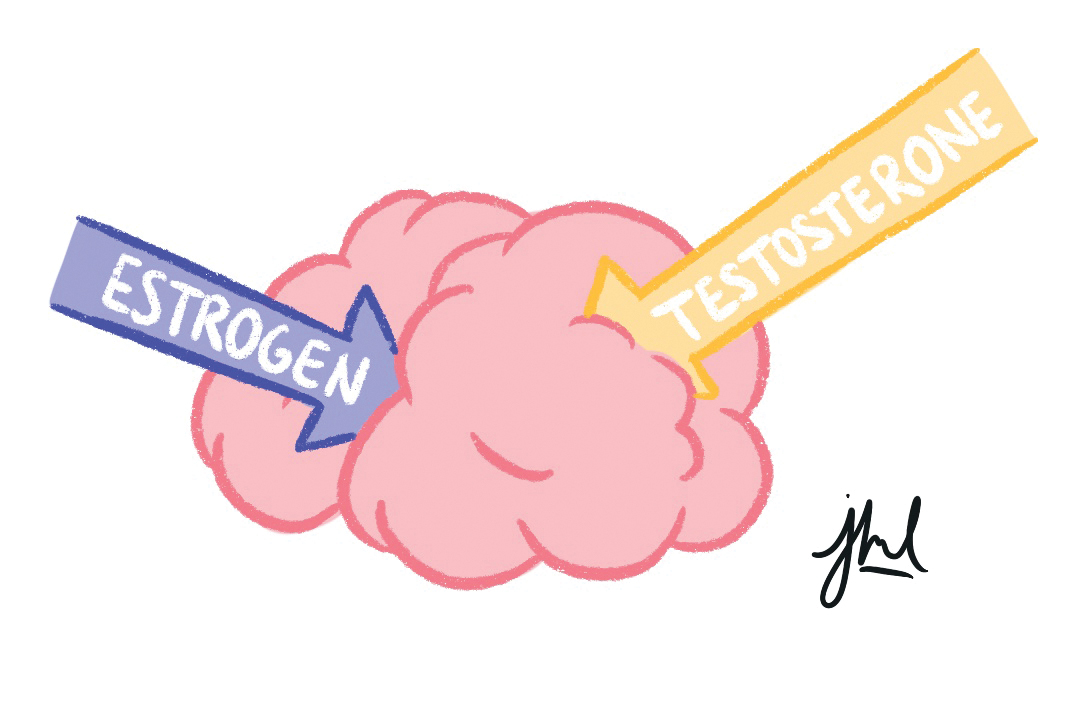There is an abundance of literature on the psychological differences between cisgender men and women. We all know the adage: “men are from Mars, women are from Venus.” The so-called ‘sex hormones’ estrogen and testosterone often take the blame — many people believe that behaviours in women are driven by estrogen and those in men by testosterone.
In fact, everyone has both steroid hormones, which play an important role in how the brain functions.
As a psychology and neuroscience PhD student, I probe the brain for relationships between these steroid hormones in different regions of the brain, particularly in the brain’s interior ‘white matter.’ The brain relies on white matter for communication between different regions of the brain and across hemispheres — similar to how the wiring of a computer sends signals between its different components. The major wires, or white matter ‘tracts,’ are made up of smaller, thinner wires called axons — the elongated parts of neurons that extend away from the main cell body.
Each axon is coated with an insulating layer of a fatty substance called myelin. The speed at which a message is delivered can be determined by the amount of this axonal insulation and the axon’s diameter. Both estrogen and testosterone have been found to influence axons’ diameter and amount of myelin they contain. In 2015, a team of U of T neuroscientists hypothesized that the hormones might work in opposing directions, with testosterone increasing axonal diameter and estrogen encouraging myelination.
In fact, I initially became interested in white matter after reading a study about the differences in signal communication induced by these hormones. These differences can be attributed to both sex and gender. Some researchers call them ‘sex/gender differences,’ a composite term intended to recognize the human entanglement of biology and socialization in sex and gender.
One important question for this line of research is whether the concentration of steroid hormones influences a brain’s ability to send messages. For example, we know that the white matter properties that are necessary to send a message in a big brain are different from those required for a small brain, and we also know that cisgender men have larger brains, on average. So it is likely that differences in axonal diameter and myelination caused by sex and gender are necessary to compensate for differences in brain size.
The myelin and axonal diameter may work in tandem to ensure that signals are quick and efficient, no matter the size of your brain. Because estrogen influences myelination, it still serves a function in the brains of cisgender men, despite its reputation as the ‘female sex hormone.’ Testosterone and estrogen may play an important role here — in all brains.
Importantly, white matter development is also experience-dependent, meaning its connections can strengthen or weaken as we learn or adapt to new environments. Our lived experiences influence how our brain is wired. Imagine how your everyday experiences have influenced your own white matter connections, and how these may differ from those of a friend or family member. For example, athletes have stronger white matter connections between the parts of their brain associated with their sport, as compared to non-athletes.
Due to the entanglement of biological sex and gender socialization — that is, how one is raised based on their assigned sex — it’s important to consider all genders and identities when assessing brain differences. This makes research on gender in neuroscience complex but critical.
The focus of my research is the association of white matter properties with steroid hormones and gender identity. To explore this, I analyze neuroimaging data of gender-diverse adolescents and adults. Neuroimaging allows me to visualize each individual’s white matter, and blood samples offer a measurement of their estrogen and testosterone levels. Hormone levels may differ across individuals and may change as a result of initiating gender-affirming hormone therapy. I then compare these differences in hormone content to differences in their white matter measurements.
Gender-affirming hormones are synthetic steroid hormones used by many transgender and nonbinary folks as one aspect of their social transition. Understanding the role of different hormones, and whether they interact with sex/gender differences in the brain’s white matter, can help individuals make informed decisions about their gender-affirming care and could help expand the access to gender-affirming care worldwide.
My research began as a challenge to better understand behavioural differences between cisgender women and men, but has since grown to appreciate the brain’s diversity. Steroid hormones have an integral role in forming white matter connections — connections that adapt to the experience and needs of the individual.


